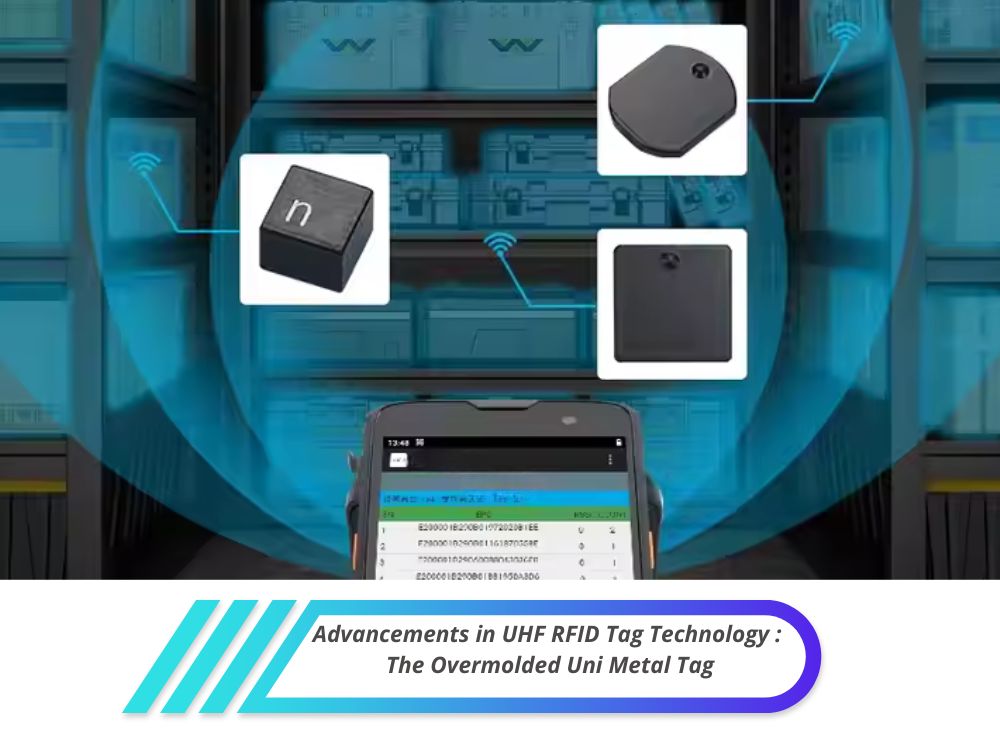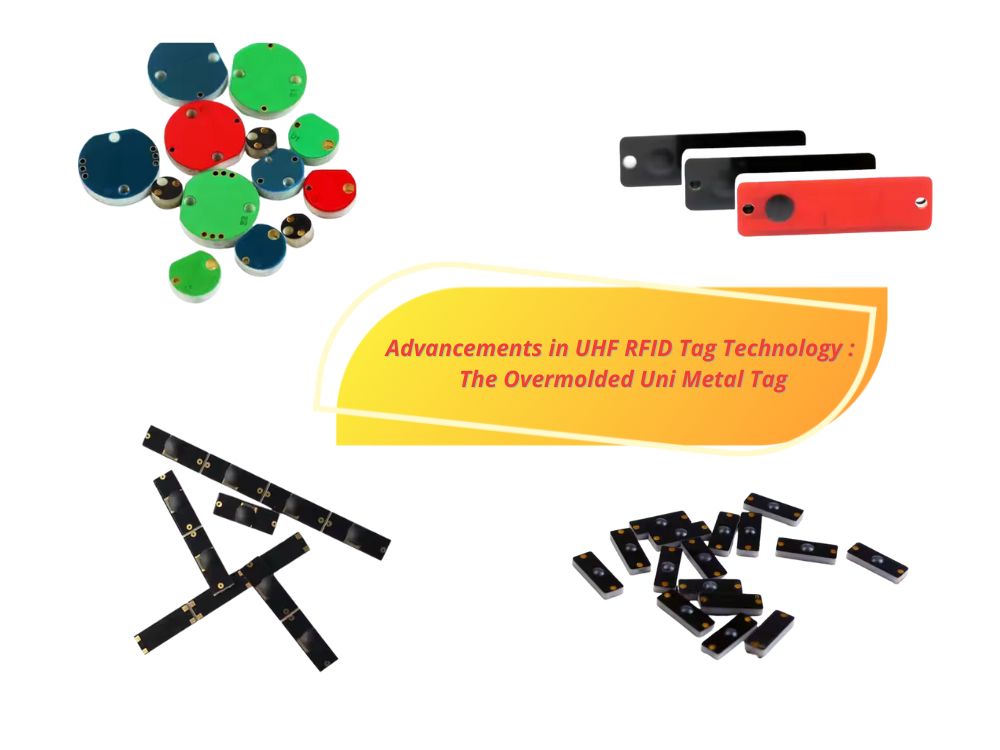
Advancements in UHF RFID Tag Technology: The Overmolded Uni Metal Tag
Table of Contents
Summary
This innovative UHF RFID tag has been designed to enhance RFID functionality on and around metal surfaces, overcoming the limitations traditionally associated with metal interference in RFID systems.

Introduction to the Overmolded Uni Metal Tag
The Overmolded Uni Metal Tag is a groundbreaking development from SAG, a company renowned for its expertise in RFID solutions since its inception in 1999. The tag addresses a significant challenge in the RFID industry: effective reading performance on metal surfaces, which often cause reflection and absorption that disrupt RFID transmissions. By integrating the metal object to which it is attached as part of the RF antenna, this tag allows for improved flexibility and performance in various industrial applications.
Key Features and Applications
Enhanced Reading on Metal Surfaces
raditional RFID tags struggle with metal interference, typically requiring a separator to maintain a functional distance from the metal surface. The Overmolded Uni Metal Tag, however, employs the metal object itself as part of its RF antenna. This design innovation enables the tag to receive and respond to RF transmissions even from the opposite side of a metal object.
Comparison of RFID Tag Performance on Metal Surfaces
Feature | Traditional Metal-Mount Tags | Overmolded Uni Metal Tag |
RF Transmission Handling | Limited; requires a separator | Enhanced; uses metal as antenna |
Tag Encapsulation | Typically in basic plastic | Industrial-grade plastic housing |
Read Performance | Optimal only on the front surface | Effective on both sides of metal |
Mass Production Feasibility | Limited | Scalable and efficient |
Versatile Applications in Industry
The Overmolded Uni Metal Tag is particularly valuable in sectors where metal interference has previously limited RFID applications. For example, in the logistics and industrial sectors, this tag is used to track metal cylinders containing liquefied petroleum gas (LPG). This application ensures that gas bottles are properly maintained and safe for refilling, streamlining the inspection process and reducing errors associated with manual tracking methods.
Industrial and Logistical Benefits
Improved Efficiency and Safety
The introduction of this advanced tag technology has significant implications for efficiency and safety in industrial settings. By automating the tracking and maintenance processes, the Overmolded Uni Metal Tag minimizes manual intervention and enhances accuracy in monitoring equipment conditions. For instance, the LPG cylinder tracking application allows operators to quickly verify the inspection dates, reducing downtime and ensuring compliance with safety regulations.

Scalability and Flexibility
SAG’s approach to creating and encoding these tags in mass production provides a scalable solution for various industrial needs. The ability to deploy these tags effectively across different environments, even when enclosed in an industrial-grade plastic housing, represents a substantial advancement in RFID technology.
Future Prospects and Developments
The Overmolded Uni Metal Tag exemplifies the ongoing innovation within the RFID industry. As metal-mount RFID applications continue to expand, further developments in tag technology and antenna design will likely emerge, addressing new challenges and enhancing capabilities across diverse sectors. SAG’s commitment to solving RFID challenges and collaborating with industry players ensures that future advancements will continue to push the boundaries of what RFID technology can achieve.
In conclusion, the Overmolded Uni Metal Tag by SAG represents a significant leap forward in overcoming metal interference in RFID systems. Its ability to function effectively on and around metal surfaces, combined with its scalable production and diverse applications, marks a notable advancement in RFID technology. As industries seek increasingly efficient and reliable solutions, innovations like this will play a crucial role in shaping the future of RFID applications.
Comments
Hot Products

What Is RFID Waste Management
Imagine a city where every trash bin speaks — not literally — but through a tiny chip that tells the system when it’s full, when it’s emptied, and where it went. That’s what RFID waste management is doing today.

What are Bolt Seals and their Applications? | Complete Guide
In global trade and logistics, bolt seals play a crucial role in ensuring cargo security and compliance. These small but powerful devices are designed to lock shipping containers, trailers, and cargo doors with a tamper-evident mechanism.

What is an RFID Card Protector? Benefits, Use Cases, and Buying Guide
RFID technology (Radio Frequency Identification) is everywhere: in your credit cards, ID badges, transit passes, hotel room keys, and more. It offers speed and convenience, but it also opens the door to a new kind of digital theft called “skimming.” That’s where an RFID card protector comes in.

RFID Wristbands for Events: Bulk Buying Guide for Organizers
RFID wristbands for events are becoming the go-to solution for organizers who need faster entry, fraud prevention, and cashless payments at concerts, festivals, and sports venues. Unlike paper tickets or QR codes, these smart wristbands use embedded chips to streamline access, secure transactions, and improve the guest experience.

How RFID Tag on Windscreen Improves Vehicle Access Control and Toll Systems
In today’s fast-paced world, vehicle identification needs to be quick, secure, and contactless. An RFID Tag on the Windscreen provides exactly that — a reliable way to manage toll collection, parking, and gated access without stopping vehicles.

The Benefits of RFID Linen Tags in Commercial Laundry
Managing laundry in hospitals, hotels, or large laundry services is a big job. Each day, thousands of sheets, towels, and uniforms are washed, sorted, and sent back out. But problems like lost linens, sorting mistakes, and manual counting can cost companies a lot of money. For example, mid-sized hotels can lose over $200,000 each year from missing linens.
That’s where RFID Linen Tags come in.
Tags
RELATED BLOGS

What Is RFID Waste Management
Imagine a city where every trash bin speaks — not literally — but through a tiny chip that tells the system when it’s full, when it’s emptied, and where it went. That’s what RFID waste management is doing today.

What are Bolt Seals and their Applications? | Complete Guide
In global trade and logistics, bolt seals play a crucial role in ensuring cargo security and compliance. These small but powerful devices are designed to lock shipping containers, trailers, and cargo doors with a tamper-evident mechanism.

What is an RFID Card Protector? Benefits, Use Cases, and Buying Guide
RFID technology (Radio Frequency Identification) is everywhere: in your credit cards, ID badges, transit passes, hotel room keys, and more. It offers speed and convenience, but it also opens the door to a new kind of digital theft called “skimming.” That’s where an RFID card protector comes in.




